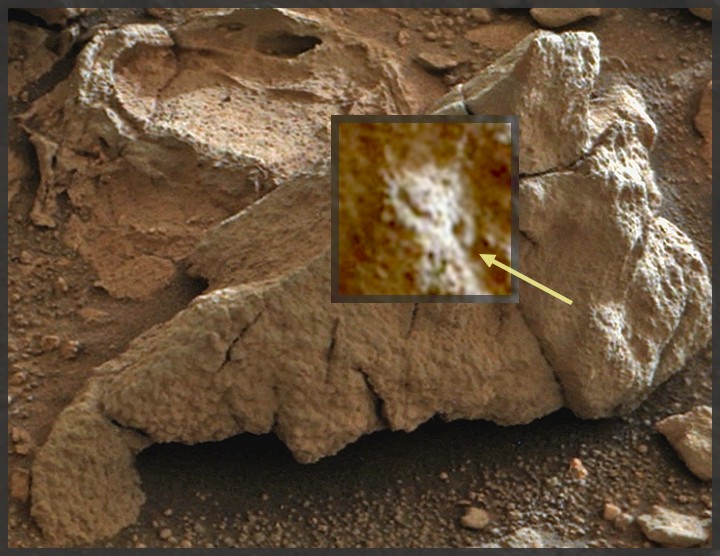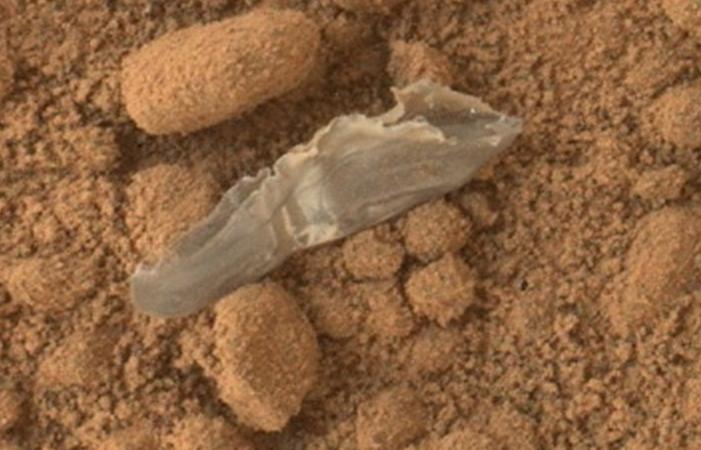It looks like you're using an Ad Blocker.
Please white-list or disable AboveTopSecret.com in your ad-blocking tool.
Thank you.
Some features of ATS will be disabled while you continue to use an ad-blocker.
share:
jeep3r
Aleister
reply to post by Blue Shift
Here's another interesting Wikipedia page, a timeline of the mission, and they now seem to be actually looking for fossils (or signs of them)
Meanwhile ... back at Yellowknife (yep, kinda 'revisited'):
Looks like something remotely 'spokey' on that edge. Could be reflections, though, difficult to tell ... might be worth checking this GigaPan of Yellowknife Bay (Sol 173), which has been completely remade using uncompressed data from the PDS imaging node.
wanted to put Jeep's spoke potential from the same gigapan here again, as it is quite interesting and presented very well (by Jeep and by the sun).
edit on 26-3-2014 by Aleister because: (no reason given)
reply to post by Aleister
looks like one of the best spokey things found so far , its good to see NASA taking up the fossil hunt though ,maybe we'll be getting a few more close ups , and by the look of sol580, they've put in some time in , nearly 580 photos looks like good fishing ahead
mast 580 coming soon at a cinema near you
funBox
looks like one of the best spokey things found so far , its good to see NASA taking up the fossil hunt though ,maybe we'll be getting a few more close ups , and by the look of sol580, they've put in some time in , nearly 580 photos looks like good fishing ahead
mast 580 coming soon at a cinema near you
funBox
alienreality
reply to post by funbox
What the heck is that little dinosaur looking thing?
That is mind boggling....
heh , that's what Godzilla thought , when he wiped his bogey on that rock
upfromthedepth'sBox
reply to post by Blue Shift
well if that hypothesis is to stand , there should be similar rock stratification in this region , I cant say I found anything quite like it yet though will be keeping an eye open ;D
funBox
well if that hypothesis is to stand , there should be similar rock stratification in this region , I cant say I found anything quite like it yet though will be keeping an eye open ;D
funBox
Regarding that gigapan,it reminds me of an image i linked to in another thread ages ago.
mars.jpl.nasa.gov... from sol 186.
P.s remember that piece of plastic that fell off curio? Well is that a mother and 2 baby bits of plastic.center rightish.
Oh ignore the bones lol.
P.s remember that piece of plastic that fell off curio? Well is that a mother and 2 baby bits of plastic.center rightish.
Oh ignore the bones lol.
edit on 26-3-2014 by symptomoftheuniverse because: (no reason given)
reply to post by symptomoftheuniverse
lots of odd looking pieces in the center of that picture , have a bonish feel about them

funBox
lots of odd looking pieces in the center of that picture , have a bonish feel about them

funBox
thanks funbox. I believe that image is very close to jeepers gigapan image. If you cut the above image down the middle,my plastic mummy and 2 babies is center of the right half
funbox
reply to post by symptomoftheuniverse
lots of odd looking pieces in the center of that picture , have a bonish feel about them
funBox
reply to post by symptomoftheuniverse
mummies and babies and mini clams , and what's that line ? probably a mini cleft or crack ,looks kind of ropey

funBox
mummies and babies and mini clams , and what's that line ? probably a mini cleft or crack ,looks kind of ropey

funBox
reply to post by symptomoftheuniverse
is that from the rover ? looks a bit shiny and clean , even with its pupa look and explosive birth holes
funBox
is that from the rover ? looks a bit shiny and clean , even with its pupa look and explosive birth holes
funBox
reply to post by funbox
NASA says it fell off the rover,after being blasted off earth and surviving the perils of entry and landing, it simply casually fell off weeks into the mission.
I say mmmm ok
NASA says it fell off the rover,after being blasted off earth and surviving the perils of entry and landing, it simply casually fell off weeks into the mission.
I say mmmm ok
reply to post by symptomoftheuniverse
hmm did they , that should be easy to corroborate , ive adjusted auto tones , and ramped up the color intensity a little

ill go see if theres any bit like this in the rover gubbings
funBox
hmm did they , that should be easy to corroborate , ive adjusted auto tones , and ramped up the color intensity a little

ill go see if theres any bit like this in the rover gubbings
funBox
reply to post by Blue Shift
as I look at it from this distance it kinda reminds me of your avatars head. who is that robot btw?
nuts/boltsBox
as I look at it from this distance it kinda reminds me of your avatars head. who is that robot btw?
nuts/boltsBox
funbox
as I look at it from this distance it kinda reminds me of your avatars head. who is that robot btw?
Robby the Robot, star of the 1950s movies Forbidden Planet and The Invisible Boy.
Blue Shift
This doesn't look so spokey in this shot:
Tip your computer screen a little until it darkens, and you may be able to see a faint outline of spokes and that signature center roundess and center-bump. And the round rim on the outside of the potential spoke area has a uniform roundness. This rock obviously has been exposed to the elements for how many nillion years (?/,) so if it originally had a much more prominent spoke structure this has eroded and faded over the eons. So make the screen darker, or tilt it up so it goes darker, and see if you might see what I'm seeing.
symptomoftheuniverse
reply to post by funbox
Reminds me of a fossil one of these.
When I saw you post this I didn't know that it had been found on Mars. It's obviously a later discard of the Martian who posed for the stone-cast for the rock on the far right

edit on 26-3-2014 by Aleister because: (no reason given)
Blue Shift
I think it would be reasonable to hypothesize that the layers are of different densities, and the lower layer could have easily eroded away faster than the top layer from exposure to that incessant gritty wind that blows around the planet.
Yes, but that's not the idea it gives me when I look at it, to me it looks like the upper (darker) layer is more recent than the lower layer.
Certainly, there are ripple shapes to be found on Mars. Some of them ripples in the sand. Some of them actual ripples in the ancient lake/sea bed caused by water. Erosion again, and you're left with little points left by the peaks in the ripples.
I know, my problem is that I get the idea that I have seen something exactly like that but I can't remember where.
Aleister
Thanks very much Jeep. I don't know how to do a screen grab, although it's probably just as simple as a hitting a couple of buttons. Maybe I'll make it my mission in life to learn (pretty low life mission expectation, maybe my mission for part of today).
Does your keyboard have a key like this one?
If it has, press it. Now you have a copy of the screen on the clipboard, so if you open any image editing program (even Paint) and use the "Paste" option (usually on an "Edit" menu) you will get that copy of the computer screen on the program, so you can crop it and post it here.
Aleister
GigaPan Source
wanted to put Jeep's spoke potential from the same gigapan here again, as it is quite interesting and presented very well (by Jeep and by the sun).
Much appreciated, Aleister ... by chance, I stumbled across something that I would consider the closest match to something we also have on Earth (provided that the feature above is not just a reflection of the sun). Here's the back part of a fossilized cupuladriid bryzoan:

Fossils of tiny cupuladriid colonies reveal extinction can lag more than one million years after its cause
A new Smithsonian study that examines 10 million years of the evolution of tiny coral-like organisms called cupuladriid bryzoans has revealed that some species of this organism lingered on earth for more than one million years after the event that ultimately caused their extinction: the rising of the Isthmus of Panama. The extremely long period that elapsed between the rising of the isthmus and the actual disappearance of these animals is causing scientists to reassess the eventual impact modern habitat loss and environmental degradation may have on organisms whose populations have been reduced and are currently under stress.
The irregular outline with spokes and the roughly triangular fragment (centerish) from where the colonies regenerate does look a bit similar. Although very unlikely, I thought I'd just point to this analogy ...
new topics
-
Spiritual Solstice
Short Stories: 59 minutes ago -
'Mass Casualty event' - Attack at Christmas market in Germany
Mainstream News: 11 hours ago
top topics
-
'Mass Casualty event' - Attack at Christmas market in Germany
Mainstream News: 11 hours ago, 26 flags -
Biden Nationalizes Another 50,000+ Student Loans as He Heads for the Exit
US Political Madness: 15 hours ago, 8 flags -
Search to Resume for MH 370
Disaster Conspiracies: 13 hours ago, 4 flags -
Sue Gray, Sir Keir Starmer's former Chief of Staff, Nominated for Peerage
Regional Politics: 15 hours ago, 3 flags -
Spiritual Solstice
Short Stories: 59 minutes ago, 0 flags
active topics
-
'Mass Casualty event' - Attack at Christmas market in Germany
Mainstream News • 97 • : Freeborn -
Mood Music Part VI
Music • 3752 • : BrucellaOrchitis -
Search to Resume for MH 370
Disaster Conspiracies • 7 • : Flyingclaydisk -
Spiritual Solstice
Short Stories • 1 • : BingoMcGoof -
An Interesting Conversation with ChatGPT
Science & Technology • 31 • : BrucellaOrchitis -
Why isn't Psychiatry involved?
Social Issues and Civil Unrest • 28 • : BrucellaOrchitis -
Smartest Man in the World Tells His Theory About What Happens At Death
Philosophy and Metaphysics • 51 • : whereislogic -
Drones everywhere in New Jersey ---and Elsewhere Master Thread
Aliens and UFOs • 205 • : GENERAL EYES -
-@TH3WH17ERABB17- -Q- ---TIME TO SHOW THE WORLD--- -Part- --44--
Dissecting Disinformation • 3771 • : 777Vader -
Democrat Governors Hold Emergency Meeting With President Biden to Assess His Mental State.
2024 Elections • 119 • : TruthJava




